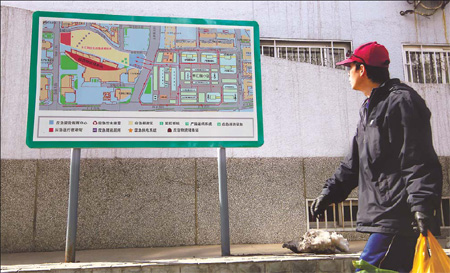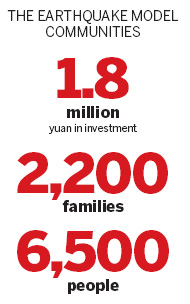|
|

A resident at Fenghuiyuan community looks at a map showing emergency facilities in the event of an earthquake. |
Experts are looking to see what lessons can be learned about earthquake readiness following an experiment that cost 1.8 million yuan and involved more than 6,500 people in two communities.
The Beijing Earthquake Administration said the initiative was China's first aimed at increasing people's knowledge of what to do after a major earthquake.
The program, which began in October 2008, wound up at the end of January and involved two residential complexes; one in the downtown and the other in a rural area.
The initiative was aimed at developing models for different types of communities with various construction styles, the administration said.

"According to statistics after the deadly earthquake that hit Tangshan, Hebei province, in 1976, 80 percent of residents escaped through self-help and rescuing efforts by neighbors," said Lan Congxin, who was in charge of the program.
Lan, who is section chief with the technology monitoring office in the Beijing Earthquake Administration, told METRO the program was created in response to disastrous earthquakes worldwide and the capital's own vulnerability.
She said it looked for ways to ensure people have the knowledge and skills they need to deal with the aftermath of a quake.
"While the capital is becoming an international metropolis, most residents still lack sufficient knowledge about earthquakes, according to our experience," she said.
The two communities that took part in the program were Fenghuiyuan and Xiangtang village.
Fenghuiyuan has 1,533 households and 4,614 residents and is near Beijing's financial street in Xicheng district.
Xiangtang village is in the Cuicun town in Changping district and comprises 754 households and 1,901 inhabitants.
In addition to setting up exhibitions and establishing education centers in the two communities, the program also established emergency shelters and arranged for the storage of emergency supplies in both areas.
In Fenghuiyuan, a 2.29-hectare grassed area was set up as a temporary earthquake shelter capable of dealing with more than 8,000 people.
Kong Lingwen, section chief with the emergency office within Xicheng district's civil defense bureau, told METRO the temporary shelter will be turned into a permanent one in the future.
He said it will include a tent-living district, potable water supply center and medical care center.
"We signed agreements with the shopping malls on financial street," Kong said. "They will store relief goods during emergencies."
But while many residents in the two communities applauded the pilot program, some didn't feel it would make much difference if a major earthquake hits.
Song Rui, 60, from Fenghuiyuan community, told METRO he had concerns.
"People would not be able to get to the shelters if the disaster was so serious that it caused buildings to collapse," he said.
Beijing has constructed 33 formal earthquake shelters in both urban and rural areas, according to data released by the administration.
|